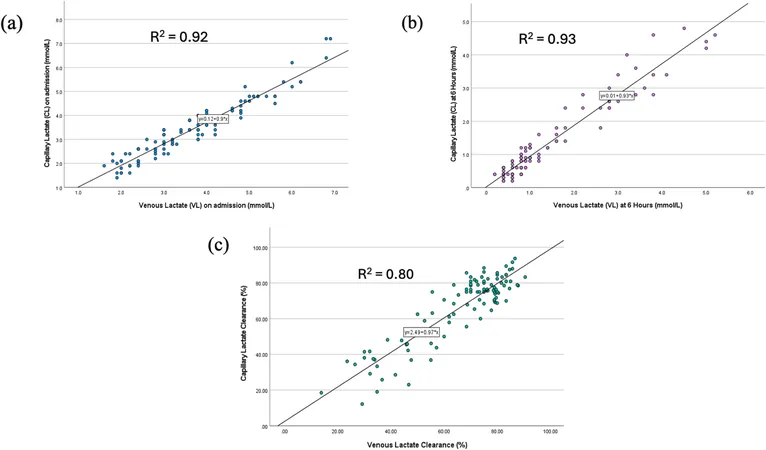
Capillary Lactate: A Game-Changer in Sepsis Prognosis and Management?
2025-03-31
Author: Nur
Introduction
Sepsis is a life-threatening condition that poses a significant challenge for healthcare systems globally. Annually, approximately 48.9 million cases lead to an estimated 11 million deaths, especially in resource-limited settings where early detection and treatment is crucial. While venous lactate (VL) has long been used as an important marker in sepsis management, its accessibility is often limited. However, capillary lactate (CL) measured with a point-of-care handheld analyser emerges as a feasible and cost-effective alternative. This article explores the correlation between CL and VL in sepsis patients and identifies key predictive cut-off values for poor outcomes.
Methods
A descriptive study was conducted in a tertiary care hospital in Sri Lanka from March to June 2022 targeting patients with suspected new-onset sepsis, classified by a quick Sepsis Related Organ Failure Assessment (qSOFA) score of 2 or more. The handheld device, "Lactate-plus," was utilized to measure CL and VL at both the initial assessment (0 hours, t0) and six hours later (t6). A robust pilot study ensured the accuracy of this device. Clinical demographics, outcomes, and responses to treatment were tracked for 28 days post-admission.
Results
Out of 102 enrolled patients with a median age of 71.5 years, findings revealed a strong correlation between CL and VL at both t0 and t6, and indicated that elevated CL levels at t0—specifically those above 3.5 mmol/L—were linked to an increased risk of mortality, vasopressor requirement, and ICU admission. Further, a capillary lactate clearance greater than 64% from t0 to t6 predicted favorable outcomes.
Conclusions
The study underscores the potential of CL as a reliable prognostic tool in sepsis management. It correlates well with VL and offers a quicker, less invasive method for assessing patient risk. Identifying patients at high risk based on elevated CL could lead to timely interventions, potentially reducing mortality rates in this vulnerable population.
Importance of Lactate in Sepsis Management
Sepsis leads to disruptions in blood flow and oxygen delivery to tissues, causing an increase in lactate levels—a marker that indicates tissue hypoperfusion. Continuous monitoring of blood lactate levels aids clinicians in assessing the severity of sepsis and response to therapy. While arterial lactate is the gold standard, VL and the emerging use of CL provide critical data at the bedside in an expedited manner.
The study indicates that robust CL measurements may serve not only as an additional tool but also as a complementary method to traditional blood lactate assessments, especially in low-resource settings where rapid diagnosis can significantly alter patient outcomes.
Clinical Implications and Future Directions
As the demand for rapid assessment tools in emergency medicine grows, the integration of capillary lactate testing could revolutionize the screening and management of sepsis. The study's findings raise the question: can capillary lactate testing become the new standard of care for sepsis management? Further research is needed to validate these findings in multicenter studies and to explore the implementation of capillary lactate monitoring in various clinical settings, including prehospital environments.
In an era where prompt diagnosis can be the difference between life and death, leveraging technologies that facilitate quick and effective patient assessment could greatly enhance the quality of care in sepsis management.
In conclusion, capillary lactate measurement represents an exciting advancement that could redefine sepsis prognostication and ultimately save countless lives.



 Brasil (PT)
Brasil (PT)
 Canada (EN)
Canada (EN)
 Chile (ES)
Chile (ES)
 Česko (CS)
Česko (CS)
 대한민국 (KO)
대한민국 (KO)
 España (ES)
España (ES)
 France (FR)
France (FR)
 Hong Kong (EN)
Hong Kong (EN)
 Italia (IT)
Italia (IT)
 日本 (JA)
日本 (JA)
 Magyarország (HU)
Magyarország (HU)
 Norge (NO)
Norge (NO)
 Polska (PL)
Polska (PL)
 Schweiz (DE)
Schweiz (DE)
 Singapore (EN)
Singapore (EN)
 Sverige (SV)
Sverige (SV)
 Suomi (FI)
Suomi (FI)
 Türkiye (TR)
Türkiye (TR)
 الإمارات العربية المتحدة (AR)
الإمارات العربية المتحدة (AR)